With only half an hour left, let’s get right back to the action in Seminar Room A. Time was running out on the first stage of a history of the OBJECT in 100 worlds, and with only three pitchers left, we knew lunchtimes at the V&A were about to get a lot more boring. Sob!
OP8/04
Our next speaker was Frank Bartlett, a member of the V&A’s Visitor Experience team, representing a group of museum staff that probably spend the most time physically with the objects on display. As Frank is on a zero-hours contract, he had to come into the V&A especially to make his pitch, delivering it on his own time – now, that’s commitment to a history of the OBJECT in 100 worlds!
Frank’s vote was for the St Margaret’s Altarpiece, a colossal object carved in wood, painted and gilded, that was once located in Lüneburg, northern Germany.

He explained the background to the object by telling us that “St Margaret was the daughter of a pagan priest, who lived in Antioch, present-day Syria, and was martyred for refusing to recant her Christian faith”, with the altarpiece narrating key episodes from her life through its carved scenes.
Like Angela, Frank explained how his object offers a bridge between today and the past. The altarpiece’s subject matter is “a connection between world of 2000 years ago and today”. Most notably, “Syria is in the news because of the [so-called] Islamic State (IS), meaning one could in theory still be executed for refusing to renounce Christian religion today.”
The altarpiece was “made in 1520 in what we now think of as Germany, and was shaped by and contributed to the Reformation, a series of events of crucial importance in early modern Europe.” As such, this object “tells us about local contexts and wider comparative European experiences.”
Thinking about where his object once stood, Frank told us that it was “positioned at the east end of the Church – the holiest place in both churches and synagogues as the sun rises in the East. This symbol of birth and rebirth links back to pre-Christian practices, as well as linking the Christian, Jewish and Pagan worlds.”
The complex construction of the altarpiece “offers valuable insights into workshop practices”, while where it was made is “evidence of trading communities and links.” Lüneburg “was part of the Hanseatic League, the commercial and defensive confederation that dominated trade along the northern European coast from the Late Middle Ages.” The League was “mostly made up of German-speaking cities, but stretched from Riga, in modern-day Latvia, to London and King’s Lynn in England.”
Shooting forward to the 19th century, when the V&A acquired the altarpiece, and to wars in the 20th century, Frank made the pertinent observation that this object, as a survivor, also “calls to mind the wealth of art, architecture and design lost during aerial bombardment of Germany during World War Two.” As something that “resonates with Germany’s tumultuous history during the 20th century, it reminds us of all the beautiful things that get destroyed during modern warfare.”
OP8/05
Our penultimate pitcher, Pippa Llewellyn, Gallery Manager in the Visitor Services team made a case for the plaster cast of Queen Eleanor of Castile’s magnificent tomb. Her choice, she told us, was informed by a childhood “love of the kings and queens of England – that’s what got me into museums in the first place.”
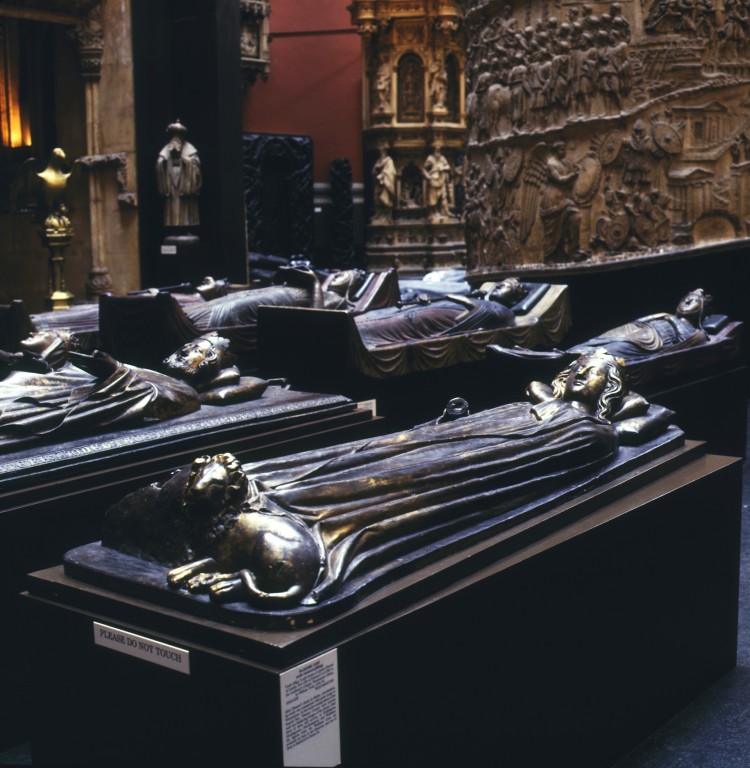
Pippa also explained that her choice of object reminded her of the place she’d grown up, St Alban’s, home to an abbey and “once the site of one of the twelve ‘Eleanor Crosses’.” These crosses “marked the overnight resting places of the body of Queen Eleanor of Castile on its journey back from Lincoln to London” and were “commissioned by her husband, Edward I, and built between 1291 and 1294.”
Pippa showed us this picture of the Victorian replica in foreground of Charing Cross, and explained that only three originals survive: at Geddington (near Kettering), Northampton and Waltham Cross. The Eleanor Cross at St. Alban’s was demolished in the 18th century.
Like Sacha Than on Object Pitch Day 7, Pippa’s choice can be found in the Cast Courts. The plaster cast, beautifully coloured to imitate bronze, represents a tomb monument that is still in situ in Westminster Abbey, as designed by William Torel.
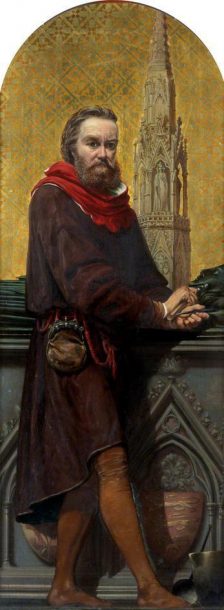
Torel “issued from a well-known family of London goldsmiths. He received royal patronage and was responsible for the fine gilt effigies of Henry III and Eleanor of Castile” found in Westminster. As Pippa argued, that we know his name at all, alongside his inclusion in the ‘Kensington Valhalla’ – the scheme of portraits in mosaic of notable artists and designers intended for the V&A’s South Court galleries – demonstrates Torel’s considerable historical reputation.
Pippa finished her pitch by dwelling on the worlds opened up by the character of Eleanor of Castile, who she described “as a shrewd businesswoman and strong influence on art, design and literature, in spite of having limited political influence.”
OP8/06
The very last pitch on the very last Object Pitch Day began with yet more bargaining. (See the conclusion to Object Pitch Day 7 to understand what I mean.) Ken Pegg, Site Manager for Cofely, argued that he deserved some extra minutes as “Bill borrowed my fan when it was very hot. I’ve still not got it back. He’s going to give me an extra minute for every month he’s had it!”
Ken was a man with a plan, explaining that his pitch was built around a series of tenuous links (“Clooney, Mickey Mouse, Metal Gear Solid, Baldrick”) that would show how his object was both part of his world and that of the V&A.
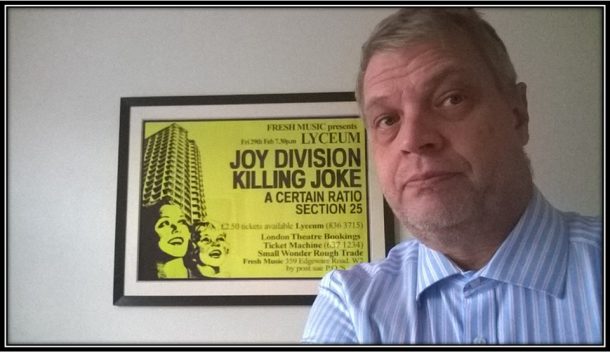
In choosing his object – Unknown Pleasures (FACT 10), Joy Division’s debut album from 1979 – Ken started by challenging museum classifications. When we say a record, like this one, has historical value, do we actually mean “the group, the album cover, the music or the influential label that put out the record? According to the V&A, the reason for its inclusion in the collection is the album cover – or to give it the correct V&A term – the record sleeve.”
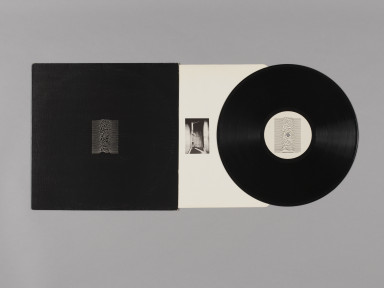
And yet, as he argued, “all of these were inputs into the record sleeve and the sleeve into them – and all of them have influenced music, design, art and even fashion in the post-Joy Division years.”
While others might offer a different cultural touchstone (“Bowie camping it up with Mick Ronson in 1972”, say), Ken presented Joy Division on television, performing on Tony Wilson’s ‘What’s On’ programme in 1978 as “the moment indelibly etched” into his memory.
At this point, we reached Tenuous Link No. 1: George Clooney. Ken explained how the “Hollywood heartthrob” was in the 2010 film, ‘The American’, directed by Anton Corbin, “one of first people to photograph Joy Division and a very well regarded rock photographer.” He has it on “good authority that George, a very big Joy Division fan, and Anton discussed relative merits of Unknown Pleasures to second album Closer over a coffee.”
Ken’s personal journey with Joy Division continued through 1978 and into 1979, as he and “best mate Dave followed the band across small, cramped, sweaty music pubs and club venues”, intoning a litany of lost music venues (“Nashville, Moonlight, Acklam Hall, Portobello Road, …the big time at High Wycombe Town Hall, even the Lyceum Ballroom on the Strand”).
He explained how Post Punk was very different from the first wave of Punk in 1977, being “darker, full of paranoia and despair, disconnected, angular, cathartic, truthful – the real musical soundtrack to Thatcher’s Britain…and it was scary.” It confirmed to “a boy from London’s suburbs that it was indeed grim up north.”
And the critics agreed. Writer Jon Savage described Unknown Pleasures as the “definitive northern gothic statement: guilt-ridden, romantic, claustrophobic”, while journalist Richard Cook concluded, “Sex has disappeared from these unknown pleasures; it is an aftermath of passion where everything is (perhaps) lost.” Ken deadpanned “I was desperately in need of a girlfriend at that time.”
And there it was: Tenuous Link No. 2: the rather surprising addition of Disney. Ken revealed a moment of corporate cluelessness in the form of this t-shirt, which morphed together Mickey Mouse’s head with the artwork for Unknown Pleasures. The t-shirt was quickly withdrawn once the company realised the “band took their name from a Nazi Prisoner-of-War sex-slave programme.”
Picking up his main narrative thread, Ken acknowledged the inputs of other legendary figures: Rob Gretton, Joy Division’s manager, who was determined they would sign for a northern label; Tony Wilson, head of the newly formed Factory Records, who famously signed the band’s contract in blood; and Martin Hannett, Factory’s demanding and obsessive in-house producer, who “kept a German Luger rifle in the studio to threaten band with if they didn’t follow orders.”
Designer Peter Saville, a recently graduated 21-year-old, had a hand in the art direction of the sleeve (“work that marked blossoming talent”); in this instance “he did little more than invert the picture: an image lifted at the suggestion of drummer Stephen Morris from The Cambridge Encyclopaedia of Astronomy that shows 100 consecutive pulses from the pulsar CP 1919.”
Joy Division’s bassist, Peter Hook, noted that Saville “listens to the music and we trust him to realise what we’re saying in a visual format. We make it for the ears and the soul, and he makes it for the eyes.”
And we were there: Tenuous Link No. 3: ‘Metal Gear Solid’, a Japanese video game designed by Hideo Kojima, who has said, “High among my inspirations are the lyrics and music of Joy Division.” This influence can be felt “in the game’s appearance and narrative, which takes place in a post-urban, post-apocalyptic dystopia.”
Winding down his pitch, Ken added a postscript, telling us that Joy Division recorded one more album, Closer (1980), before their lead singer, Ian Curtis, “committed suicide just before the band’s first US tour”, tracing Joy Division’s huge influence across genres (“Indie, House, Electro, Goth”) and on bands from U2 to The Cure, and Interpol to the Killers.
Ken’s personal journey with Joy Division also continued after the band disbanded: amongst other highlights, he witnessed “the first show at Heaven of New Order”, the band formed by the remaining members of Joy Division; listed Unknown Pleasures at 24 in a chart of his “favourite albums in his 40-Year Love of Music – between Marvin Gaye’s What’s Going On? and Patti Smith’s Horses”; and attended Live_Transmission: Joy Division Reworked, an orchestral reimagining of the band’s music with his son Charlie.
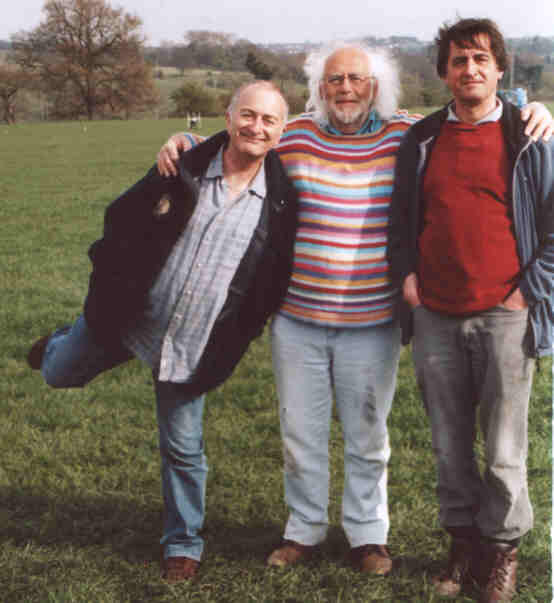
And then we reached it: the most intriguing Tenuous Link of all: Baldrick. Offering compelling evidence that you should never lend your records to television’s Tony Robinson, Ken recalled attending “a party in Islington in 1979” where he took his “new 1/1000 first UK pressing of Unknown Pleasures – the one with the textured sleeve – and insisted it was played.” Robinson was also present and was so taken by what he heard that he “asked to borrow the album so he could tape it; “filled with generosity and cheap wine”, Ken agreed and never got his album back.
“When I see him on TV doing his digs in the ancient and modern worlds, I am not angry or bitter. I just wonder during his quiet digging moments whether he has Unknown Pleasures playing on his Walkman and whether he has my rare and valuable first pressing.”
In summing up his intricate and incredibly wide ranging pitch, Ken finished where it all began: “30-plus-years ago I knew I was in the presence of a great talent listening to this band. Unknown Pleasures is the greatest rock debut album ever. And they were the greatest live band I have seen – or will ever see. Although the sleeve is the reason the record is in the collection, it is what’s inside that needs to be discovered: that’s the real unknown pleasure.”
***
We were there: the conclusion of the very last pitch of the history of an OBJECT in 100 worlds. As Bill Sherman suggested in his closing remarks, we have an “incredibly difficult job collectively ahead of us to pick just one of the amazing objects we’ve heard about.”
That might well be the understatement of the century! In a little under three months, we’d crossed continents; travelled from the ancient to the contemporary world; contemplated materials, makers, designers and techniques; imbibed every kind of approach to object-focused research; attended to the undoubted star objects of the collection and uncovered hidden treasures. But most of all, we’d shared the many kinds of expertise found in the V&A: from collections curators, consultants and conservators, through researchers, assistants and administrators, to collections management, visitor services and security… the list could – and should – go on and on.
So, what happens next? Effectively, the pitch sessions resulted in two separate but crucially related projects: the one we’d set out to do: our riff on the British Museum’s History of the World in 100 Objects, and, less expected, and as Bill framed it, “the history of a history of an OBJECT in 100 worlds: the V&A, its staff and collections right now, and the extraordinary portrait it provides of how people are approaching the institution and the things in it at this very moment.”
We’ve got some exciting ideas about where the project goes next, but for the moment, we can only ask you to watch this space…